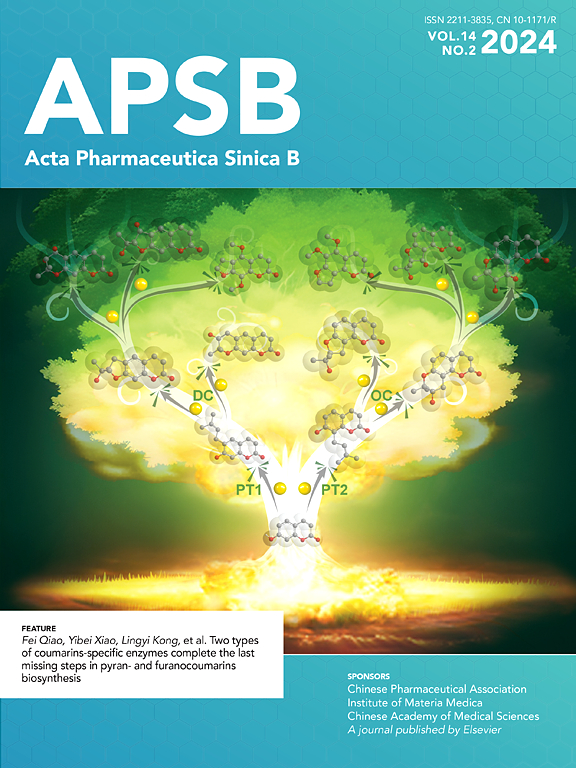GRK2激活TRAF2-NF -κB信号,促进类风湿关节炎成纤维细胞样滑膜细胞过度增殖
IF 14.7
1区 医学
Q1 PHARMACOLOGY & PHARMACY
引用次数: 0
摘要
G蛋白偶联受体激酶2 (GRK2)参与G蛋白偶联受体(GPCR)的磷酸化和脱敏,影响炎症和细胞增殖等多种生物学过程。GRK2的表达和活性失调在类风湿性关节炎(RA)的多个细胞中有报道。然而,GRK2是否以及如何调节滑膜增生和成纤维细胞样滑膜细胞(FLSs)增殖尚不清楚。在本研究中,我们研究了GRK2在RA中的调控及其生物学功能。我们发现GRK2在RA患者和胶原诱导关节炎(CIA)大鼠的FLSs中跨膜活性增加。此外,我们注意到细胞膜上GRK2的高表达与RA和CIA相关的血清学标志物呈正相关。免疫沉淀-质谱和下拉分析显示肿瘤坏死因子受体相关因子2 (TRAF2)是GRK2的一种新的底物。此外,表面等离子体共振(SPR)和分子对接实验确定GRK2的c端与TRAF2的c端在Gln340残基上结合。GRK2敲除和GRK2抑制剂CP-25通过降低GRK2膜的表达和活性,在体外和体内均可减轻CIA滑膜增生和FLS增殖。从机制上讲,GRK2跨膜活性的增加有助于细胞膜上TRAF2的募集,促进GRK2 - TRAF2的相互作用,促进E3泛素连接酶TRIM47向TRAF2的募集。这增强了TRAF2 Lys63多泛素化,诱导核因子(NF)-κB活化,导致滑膜增生和FLSs异常增殖。我们的研究为进一步评估GRK2作为RA治疗靶点提供了机制和临床前理论依据。本文章由计算机程序翻译,如有差异,请以英文原文为准。

GRK2 activates TRAF2–NF-κB signalling to promote hyperproliferation of fibroblast-like synoviocytes in rheumatoid arthritis
G protein-coupled receptor kinase 2 (GRK2) participates in the phosphorylation and desensitization of G protein-coupled receptor (GPCR), impacting various biological processes such as inflammation and cell proliferation. Dysregulated expression and activity of GRK2 have been reported in multiple cells in rheumatoid arthritis (RA). However, whether and how GRK2 regulates synovial hyperplasia and fibroblast-like synoviocytes (FLSs) proliferation is poorly understood. In this study, we investigated the regulation of GRK2 and its biological function in RA. We found that GRK2 transmembrane activity was increased in FLSs of RA patients and collagen-induced arthritis (CIA) rats. Additionally, we noted a positive correlation between high GRK2 expression on the cell membrane and serological markers associated with RA and CIA. Immunoprecipitation–mass spectrometry and pull-down analyses revealed tumor necrosis factor receptor-associated factor 2 (TRAF2) as a novel substrate of GRK2. Furthermore, surface plasmon resonance (SPR) and molecular docking assays determined that the C-terminus of GRK2 binds to the C-terminus of TRAF2 at the Gln340 residue. GRK2 knockdown and the GRK2 inhibitor CP-25 attenuated synovial hyperplasia and FLS proliferation in CIA both in vitro and in vivo by decreasing GRK2 membrane expression and activity. Mechanistically, increased GRK2 transmembrane activity contributed to the recruitment of TRAF2 on the cell membrane, promoting GRK2–TRAF2 interactions that facilitate the recruitment of the E3 ubiquitin ligase TRIM47 to TRAF2. This enhanced TRAF2 Lys63 polyubiquitylation and induced nuclear factor (NF)-κB activation, leading to synovial hyperplasia and abnormal proliferation of FLSs. Our study provides a mechanistic and preclinical rationale for further evaluation of GRK2 as a therapeutic target for RA.
求助全文
通过发布文献求助,成功后即可免费获取论文全文。
去求助
来源期刊

Acta Pharmaceutica Sinica. B
Pharmacology, Toxicology and Pharmaceutics-General Pharmacology, Toxicology and Pharmaceutics
CiteScore
22.40
自引率
5.50%
发文量
1051
审稿时长
19 weeks
期刊介绍:
The Journal of the Institute of Materia Medica, Chinese Academy of Medical Sciences, and the Chinese Pharmaceutical Association oversees the peer review process for Acta Pharmaceutica Sinica. B (APSB).
Published monthly in English, APSB is dedicated to disseminating significant original research articles, rapid communications, and high-quality reviews that highlight recent advances across various pharmaceutical sciences domains. These encompass pharmacology, pharmaceutics, medicinal chemistry, natural products, pharmacognosy, pharmaceutical analysis, and pharmacokinetics.
A part of the Acta Pharmaceutica Sinica series, established in 1953 and indexed in prominent databases like Chemical Abstracts, Index Medicus, SciFinder Scholar, Biological Abstracts, International Pharmaceutical Abstracts, Cambridge Scientific Abstracts, and Current Bibliography on Science and Technology, APSB is sponsored by the Institute of Materia Medica, Chinese Academy of Medical Sciences, and the Chinese Pharmaceutical Association. Its production and hosting are facilitated by Elsevier B.V. This collaborative effort ensures APSB's commitment to delivering valuable contributions to the pharmaceutical sciences community.
 求助内容:
求助内容: 应助结果提醒方式:
应助结果提醒方式:


